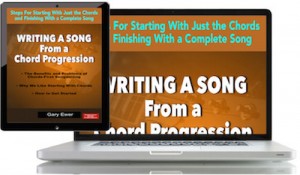When you get an idea for a song, you’re actually getting several ideas all at once. That’s how creativity works. You might think that you’ve just conjured up a single entity called a hook, but in fact you’ve brought together at least 3 different things very quickly:
- A catchy little melodic bit;
- A chord progression to support the melody;
- An enticing rhythm, with perhaps a few words of lyrics.
Because those 3 bits come together so quickly, you find yourself assessing the entire hook to decide if it’s working for you. If you don’t particularly like it, you toss it and try to create something else. That’s what songwriting is: creating ideas, keeping the good ones and tossing the bad ones.
The more music you write (that’s my polite way of saying “The older you are…”), the more you realize that there’s not a lot of difference between a good song and a bad one. It doesn’t take much to fix a song with a problem, and in so doing, you can go from having a dud to something really fine with just a few small changes.
So here’s an option for what to do about a hook you’ve just created but that you don’t particularly like: try improving it before giving up on it. The surprise might be in how close you are to something really great.
Since most hooks will occur to you as a prefabricated musical unit — the melody, chords and rhythm already assembled — your first job is to separate the elements and examine them carefully on their own.
Here’s a list of steps you can use to take a preexisting hook and make some improvements:
- Manipulating the melody:
- Speed it up and slow it down. Changing tempo manipulates the mood in really obvious ways, and changes the character of the hook right away.
- Change the backing rhythm and/or time signature. Changing the rhythm also changes the mood, and you’ll notice that the rhythmic changes may also suggest changes in the lyric as well.
- Change a note in the tune. You’ll be surprised that simply changing one note can completely change the character of a melody, so spend some time with this option.
- Invert the melody. If your melody is mainly an upward-moving gesture, for example, start on the same note and experiment by moving the melody downward. It takes some work before you find the notes that will work with the chords you’ve chosen, but flipping the melody over in this way might reveal a shape that’s more interesting than the one you initially thought of.
- Manipulating the chords:
- Sing your melody, and find chord substitutions that work. (If you’re not sure how to do this, check out this article.)
- Change the harmonic rhythm. Harmonic rhythm refers to how frequently chords change. In most songs, there is a regularity — a pattern — that seems to work: every 2 beats, or every 4 beats, for example. In the hook you’re trying to fix, see what happens if you change how often chords change. (You’ll need to invent a new progression if you swtich to faster chord changes.)
In the attempt to fix your hook, you get to practice an important part of becoming a better songwriter: the ability to dissect music into its constituent elements. Audiences can’t usually do this. It’s hard for them to imagine a well-known melody being accompanied by completely different chords.
The more you renovate your initial musical ideas in this way, the better you become at hearing music as a collection of separate elements, and the better you become at being able to identify problems with your writing.
 Written by Gary Ewer. Follow Gary on Twitter
Written by Gary Ewer. Follow Gary on Twitter
 If you consider yourself more of a chords-first songwriter, get Gary’s eBook, “Writing a Song From a Chord Progression“. It describes the pros and cons of starting a song with the chords, and gives you a useful set of procedures for getting the job done.
If you consider yourself more of a chords-first songwriter, get Gary’s eBook, “Writing a Song From a Chord Progression“. It describes the pros and cons of starting a song with the chords, and gives you a useful set of procedures for getting the job done.










